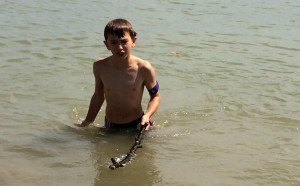
Leo Scribner is like your average 12-year-old about to finish the seventh grade — decked out with a snapback, a hoodie and skateboard — in every way except two. He’ll dominate you in the swimming pool, and he won’t let his type-1 diabetes stop him.
Leo’s been swimming since he was 6, when his mom, Carol, signed him up for lessons. The family went to Chesapeake Bay every summer to fish and crab by Carol’s mom’s cottage, so she wanted him to be safe in those deep, murky waters. At first, he only swam in the summer, but he was good and he was competitive, so he started doing it year-round at the age of 9.
Then, in February 2014, a year and a half into Leo’s competitive career, everything changed. It started with a bout of the flu that he got over but never fully recovered from. He was lethargic, constantly dehydrated and yet still going to the bathroom all the time. He had trouble breathing, and his weight dropped to about 60 pounds from the low 70s. When Leo’s symptoms got too severe to ignore, he took a day off from school and Carol took him to the doctor.
They knew it was diabetes right away.
“You gotta go down to Children’s [Hospital],” the doctor told Carol. She expected to get an appointment the following day, but the doctor said it had to happen immediately.
When they got there, Leo’s blood sugar was nearly 10 times higher than normal levels. He was diagnosed with juvenile diabetes, and Carol called Leo’s dad, Tom, to break the news. She says they went into autopilot, talking to doctors and nurses, going to classes about diabetes education, learning what they had to do.
“I was kind of in shock,” Leo says.
He handled the diagnosis about as well as a 10-year-old can, though. The day after he heard the news, he told his dad he would overcome the limitations. But first, he had to deal with the uncertainty of what it meant for his swimming.
“I thought that was kind of the end of it, and that I wouldn’t be able to do more sports or anything like that,” Leo says. “But the doctors said I could do anything.”
For the first three months after his diagnosis, Leo used an insulin pen. He’d test his blood sugar, calculate manually how much insulin he needed, and then he’d give himself a shot. He had to do this every time he ate — sometimes five or six times a day. Then he switched to a pump that attaches to his arm and connects to a monitor over Wi-Fi. He tests his blood sugar seven or eight times a day, inputs how many calories he’s eating, and the monitor tells the pump how much insulin to dispense. Leo only has to change the pump every three days, and, most importantly, it’s waterproof.
“It kinda just worked out,” Leo says about fitting his insulin monitoring into his routine. “Usually, I’ll be fine, but if my blood sugar is low I’ll just have a snack.”

Leo had to adjust to his new routine quickly, because the Colorado state swimming championships were only six months out from his diagnosis. He trained relentlessly, hitting the pool twice a day at times, scrutinizing every bit of food he ate. He was so determined to win; then, on race day, he barely lost the 50-meter breaststroke to his best friend. Even so, he was surprised when he found out his friend was seeded above him for the next day’s 100-meter.
“Leo, you’re better at the 100 than the 50,” his dad told him. “He just barely beat you in the 50. I think you can win in the 100.”
Leo thought he could win, too, but he had no idea how he was doing once he got in the pool. The swim goggles and the splashing limited his peripheral vision to the point where he couldn’t see the other racers, so he just pushed. He thought he was neck-and-neck with them until he finished — then he realized how far behind everyone else was. When he got out of the pool, his friend’s sister ran down to meet him.
“Leo, you broke the course record,” she told him.
“It was kind of a milestone,” Carol says. “That race was a moment. It was amazing.”
Leo took it easy from competitive swimming for a while after that — he’d certainly earned it — but now he’s getting back at it. Earlier this April, he took first place in fly, freestyle, butterfly and breaststroke at a meet in Longmont. He’s training for regionals, and is close to qualifying in the 100-meter and 200-meter breaststroke. He skateboards for fun and joined the cross-country team; his mile is down to 6 minutes, 10 seconds.

He’s even planning to run the BolderBoulder on Memorial Day.
“When you run the BolderBoulder this year,” Carol says to her son, “You’re gonna have to find somebody else to run with other than mom and dad because neither one of us can keep up with you.”
The diabetes will always be there, but Leo is taking it in stride, monitoring his blood sugar, watching what he eats, never getting complacent. He’s diligent about it when he’s training, at home or out with friends, like the post-practice Starbucks run a couple days ago when his insulin pump failed. But Leo didn’t just order something anyway. He can’t cheat with this part of his daily routine like he can with brushing his teeth or taking a shower. So he called his mom, and she rushed him a new pump right away. His insulin is the most important part of his daily routine, and in a way, that makes it easier. Carol looks at it like any other life-critical decision.
“Are you gonna run across the street when a car is going by? No. Are you gonna wait for the car to pass? Yeah,” she says. “It’s that simple.”














